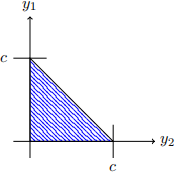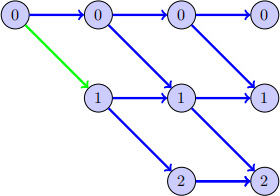ECE-GY 6013. Digital Communications Final Exam Solutions, Spring 2019
Hello, dear friend, you can consult us at any time if you have any questions, add WeChat: daixieit
ECE-GY 6013. Digital Communications
Final Exam solutions, spring 2019
Answer ALL questions. Exam is closed book. No electronic aids. But, you are permitted two cheat sheets, two sides each sheet. Any format for the cheat sheet is permitted. part marks are given. If you do not remember a particular MATLAB command or its syntax, use pseudo-code and state what syntax you are assuming.
You may answer on the exam sheet or in the provided blue book. But, if you use a blue book, please indicate on the exam paper. You must turn in the exam paper at the end of the exam. You may keep your cheat sheet.
1. sgmbol detection. consider a constellation with three complex points s1 = O, s2 = A and s3 = iA. You receive r = sm + 山, 山 … CN (O, N0 ). Let ![]() be the ML detected symbol from r.
be the ML detected symbol from r.
(a) Draw the decision regions for the three values, ![]() = s1 , s2 , s3 , on the complex plane.
= s1 , s2 , s3 , on the complex plane.
(b) Find the probability of error P (![]()
![]() s1 |s = s1 ). write your answer as a two-dimensional integral. If you can solve the integral in terms of Q-functions, do so. otherwise, at least, indicate the limits of the integral.
s1 |s = s1 ). write your answer as a two-dimensional integral. If you can solve the integral in terms of Q-functions, do so. otherwise, at least, indicate the limits of the integral.

Figure 1:constellation points and decision regions for problem 1
2. Detection simulation. consider a channel,
Tj = sjeiθj + 山j, 山j … CN (O, N0 ),
where sj are Qpsk symbols with |sj| 2 = Es; θj is a random phase error and 山j is AWGN noise. Write a few lines of MATLAB code to:
. Generate n = 1OOOO Qpsk symbols, sj .
. Add phase errors θj uniformly distributed in [-O.2π, O.2π].
. Add noise at an sNR of Es/N0 = 5 dB.
. Demodulate the Qpsk symbols. Assume the demodulator does not know the phase error.
. Measure the bit error rate.
. Measure the symbol error rate.
Assume you are given the following MATLAB functions:
各 Random n伪m备们r g们n们ra大ors .
各 Each 毛伪nc大ion g们n们ra大们s an (n ,m) ma大riX
X = randi([a,备], n, m); 各 random in大们g们rs 毛rom a 大o 备 incl伪siv们
X = rand(n, m); 各 伪ni毛orm n伪m备们rs 毛rom 0 大o 1
X = randn(n, m); 各 伪ni大 Ga伪ssians
各 QpSk mod伪la大ion and d们mod伪la大ion .
各 Do no大 ass伪m们 大h们s们 hav们 伪ni大 norm o伪大p伪大s
s = qpskmod(备i大s);
备i大s = qpskd们mod(r);
3. sgnchTonization and detection we wish to detect if a signal transmitted (① = 1) or not transmitted (① = O). we obtain M independent power measurements y = (g1 , . . . , gM ). Assume that conditional on ① = O, 1, the M powers measurements are independent and exponentially distributed,
p(gi| ① = j) = λje-)jgi, i = 1, . . . , M,
where λ0 持 λ 1 .
(a) Find the LLR, L(y) := ln p(p)![]() y(y)
y(y)![]() 从(从)
从(从)![]() 0(1)
0(1)![]() .
.
(b) consider the LLR detector that selects ![]() = 1 when L(y) > t for some threshold t. Draw the decision region for ① = 1 for the case M = 2 on the (g1 , g2 ) plane. Label the axes.
= 1 when L(y) > t for some threshold t. Draw the decision region for ① = 1 for the case M = 2 on the (g1 , g2 ) plane. Label the axes.
(c) Find the probability of false alarm for the detector in part (b). Your answer will have a double integral. You do not need to solve it, but clearly indicate the limits of the integral.

Figure 2: Decision region for ① = O in problem 3
4. OFDM numeTologg consider an OFDM system with Nsc = 4OO occupied subcarriers and sub-carrier spacing Δf = 2O KHz.
(a) If the FFT is must be a power of 2, what is the smallest FFT size, NF FT? (b) what is the sample rate with the FFT size in part (a)?
(c) what is the occupied signal bandwidth of the discTete-time signal after the OFDM modu- lation? Note that the discrete-time occupied bandwidth is a subset of the interval [ -π, π].
5. OFDM Channel equalization. suppose that the received symbols on subcarrier n are given by,
T [n] = h[n]① [n] + 山 [n], 山[n] … CN(o, No ), | ① [n]| 2 = E① .
where h[n] is the complex channel gain; ① [n] is the transmitted symbol and 山 [n] is i.i.d. noise.
(a) suppose the baseband equivalent channel response has two taps, h(t) = A1δ(t - T1) + A2δ(t - T2). what is the OFDM channel response h[n]? your answer may depend on the OFDM parameters such as sub-carrier spacing or OFDM symbol period. Make any reasonable assumptions.
(b) suppose you take the estimate,

6. LineaT Codes. consider a linear code,
c1 = b1 , c2 = b2 , c3 = b1 + b2 .
For each coded bit ci, you get a value

where Ni is a noise power that varies with the symbol index i.
(a) Find a function, J(s) such that the ML codeword s maximizes J(s). The metric function may depend on the noise powers Ni and received values ri .
(b) What is J(s) for the corresponding to the input bits b = (1, 0)?
(c) What is the minimum distance, dmin, between two codewords s = (s1, s2, s3) in terms of Eb, the energy per information bit?
7. conuolutional codes. consider the convolutional code,
c1n = bn + bn-1 , c2n = bn-1 + bn-2 .
(a) Encode b = (1, O, 1). Make sure you add su伍cient number of tail bits.
(b) suppose you use this code blocks of 1OO information bits and 16-QAM modulation at a symbol rate of 2O Msym/s. what is the information rate, accounting for the loss with tail bits.

Figure 3: Decision region for ![]() = O in problem 3
= O in problem 3
8. ⅤiteTbi algoTithm. suppose that a state ①t E {O, 1, 2} evolves as
①t+1 = min{2, ①t + bt}, ①0 = O, b t E {O, 1}.
(a) starting at the state ①0 = O, draw the trellis diagram for ①0, ① 1, . . . , ①T up to time T = 3. Indicate on your drawing which paths branches are for bt = O and which branches are for bt = 1.
(b) suppose you get measurements Tt , t = O, 1, . . . , T of the form,
Tt = ①t(2) + 山t, 山t “ Ⅵ (O, σ2 )
where 山t are i.i.d. and independent of bt. Describe how you would set the node metrics and/or branch metrics such that the ML codeword corresponds to the lowest sum metric path.
(c) suppose the node metrics are given below. use the viterbi algorithm to ind the path with the smallest sum metric. what is the corresponding input bits (b0 , b1 , b2 ).

2023-09-12